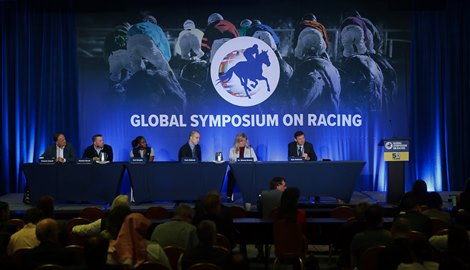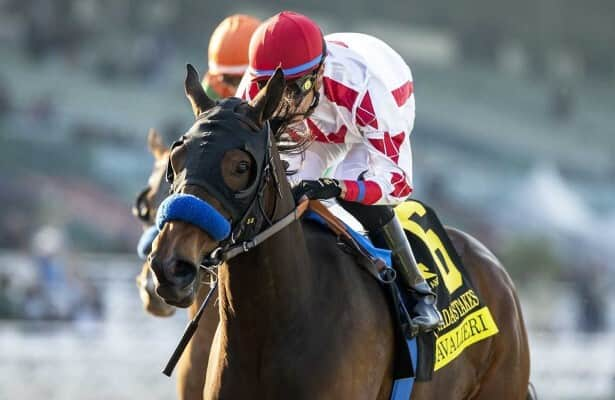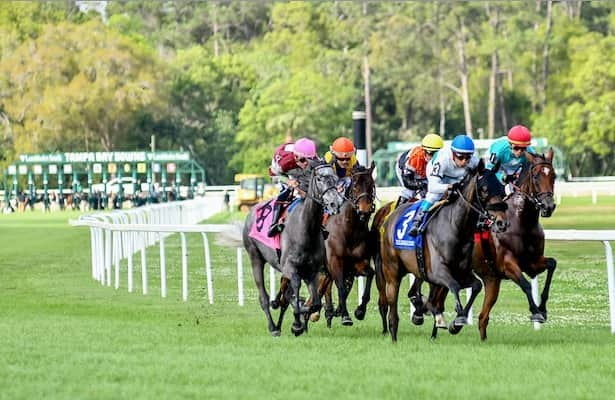Technological advances in artificial intelligence and AI applications to the equine industry were in focus during a morning session of the University of Arizona Race Track Industry Program’s Global Symposium on Racing Dec. 10 in Tucson.
Following introductory remarks from Tommy Lloyd, coach of the University of Arizona men’s basketball team; Louis Cella, president of Oaklawn Park; and Lisa Lazarus, CEO of the Horseracing Integrity and Safety Authority, six speakers with contrasting roles in the industry described the role of AI during a well-attended session titled “Artificial Intelligence: Transformative Applications for Advancing Horse Racing.”
Moderator Kyle McDoniel, president and COO of Equibase, began by describing practical applications of AI for that racing website’s data provider. He mentioned Equibase’s collaboration with companies on machine learning product that provides insights to handicappers and another that utilized earth-mounted sensors to track horses’ high-speed works, leveraging expertise space companies.
Ricardo Valerdi, department head for the University of Arizona’s systems and industrial Engineering, told the audience how relatable AI has become. Plugging relatively dry promotional materials about the Symposium into Google NotebookLM, he played portions of a 20-minute AI-generated podcast in which a computerized male host and a computerized female host discussed panels at the Symposium, even excitedly discussing the moisture content of dirt from a track maintenance panel.
Later, Mike Nova, founder of Backstretch and Contest Jockey, described converting condition books into a machine-readable format for easier access and analysis. Zoë Nengite, enterprise technical lead and senior architect for Palantir Technologies, reflected on her group’s work for the Horseracing Integrity and Safety Authority to isolate risk factors in horses and reduce breakdowns.
Mark Midland, co-founder and CEO of Horse Racing Nation, elaborated on that group’s use of AI to compile the morning lines at Colonial Downs, provide handicapping data for horseplayers, and confirm and find additional risk factors for horses, such as an animal’s weight.
“Anybody that’s going to go out for a run this afternoon, you know that weight does have a factor on your knees, your ankles, and things like that,” Midland said.
He suggested that getting some AI handicapping data and practical applications to horseplayers could level the playing field somewhat with computer-assisted wagering companies, which already utilize machine-learning programs. Those CAW groups also benefit from immediate wagering pool access and the receipt of rebates.
Dr. Dionne Benson speaks at the Global Symposium of Racing
Dr. Dionne Benson, chief veterinary officer for 1/ST Racing, wrapped up the panel with a detailed review of Racehorse 360, a program she discussed at a previous Symposium.
She explained the use of cameras and computer software at 1/ST Racing tracks such as Santa Anita Park has allowed them to acquire real-time data and immediately share that information with veterinarians. She played a clip of computerized video footage isolating a horse with an irregular gait and an interface that veterinarians can utilize, showing computer-generated risk factors for each horse entered on a given card.
She mentioned the use of real-time data as vital for veterinarians during busy training periods of “morning rush hour” when many of the 2,000 horses stabled at Santa Anita Park are headed out for training on its main or training track.
“You don’t have to have anything on the horse. It’s completely hands-off,” she said. “It picks up every horse on the track simultaneously. You can actually pick up 100 horses at a time if you use certain cameras.”
The morning sessions then wrapped with “Going Global: Updates and Insights from the World Stage,” in which panelists shared how racing organizations worldwide are handling their business.












